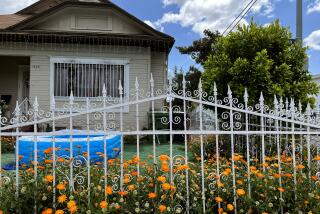CHINATOWN/ECHO PARK : ‘Forgotten Edge’ Takes a Stand
Betty Oyama was tired of living in the Bermuda Triangle of neighborhoods.
A resident of Figueroa Terrace, a hilly street between Chinatown and Echo Park, Oyama had heard neighbors gripe about being transferred back and forth between the Central and Northeast police divisions whenever they tried to phone in a crime report.
The Police Department couldn’t figure out where Figueroa Terrace and a pocket of neighboring streets were. Some local residents said they grew so frustrated that they stopped reporting the frequent auto thefts, assaults and carjackings.
After her parents were victims in a follow-home robbery a couple of years ago and it took police about five hours to arrive, Oyama decided that she had had enough. She began knocking on doors to rally residents to form a Neighborhood Watch group. And the name she selected for the group reflects the neighborhood: Forgotten Edge.
Today, as it nears its two-year anniversary, the Forgotten Edge Neighborhood Watch is a model of community participation.
The neighborhood, located off Sunset Boulevard, near the Pasadena Freeway just below Elysian Park, is a mix of new and old housing styles and residents who span the socioeconomic and ethnic spectrums. New condominium complexes stand next to 1920s-era bungalow houses and old apartment buildings. Families of 10 live next door to singles and college students.
But neighbors know each other well, watch out for one another and meet to paint out graffiti. A telephone list unites the group’s 50 active members. More important, police officers have come to know the neighborhood, which officially lies in the Northeast Division.
Officer Joe Writer, the division’s senior lead officer in the area, has become an important contact for Forgotten Edge residents. He attends their meetings on the second Tuesday of each month to report on crime trends and prevention and to hear firsthand their concerns.
Even bicycle patrol officers from the Central Division occasionally pedal into the neighborhood to check on residents.
“It’s working because people know now (whom to call). . . . They’re reporting crime. Before, they lived in a vacuum,” said Writer. “They have a relationship with the Police Department on an ongoing basis.”
Building on this relationship is an ongoing process, residents said. Because of the neighborhood’s mix of ethnicities and languages, informing and persuading non-English speakers to get involved in Neighborhood Watch has been a challenge, residents said.
Oyama, who speaks Chinese, and other bilingual Forgotten Edge members regularly go door to door with police officers to provide bilingual crime-prevention information and to check for unreported crimes among the Chinese- and Spanish-speaking residents, who often do not call police because of language and cultural barriers.
Oyama said residents still must occasionally practice patient persistence when calling police: “Even now when we call the front desk at Northeast Division, officers say, ‘You’re not in our division.’ ”
But the Forgotten Edge’s successes are significant. Writer said neighborhood gang activity has decreased because of the community’s more watchful eyes.
And the improved communication among neighbors pleases Ken Urheim, a six-year resident of the area.
“A few years ago, I had a break-in and my neighbor watched and didn’t do anything about it,” said Urheim, whose rented Figueroa Terrace house offers a breathtaking view of the Downtown skyline. “The neighbor said, ‘I thought maybe you were moving out.’
“But now, my neighbor over here watches out for me and I watch out for her. And I watch Betty’s rental property over here . . . because you never know.”
More to Read
Sign up for Essential California
The most important California stories and recommendations in your inbox every morning.
You may occasionally receive promotional content from the Los Angeles Times.










